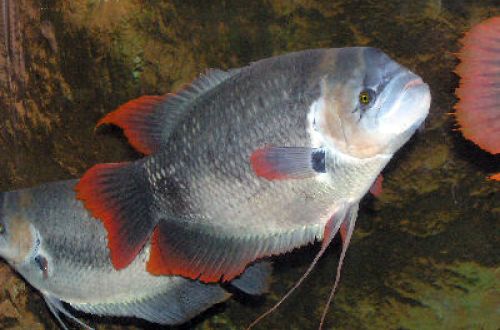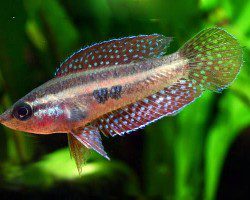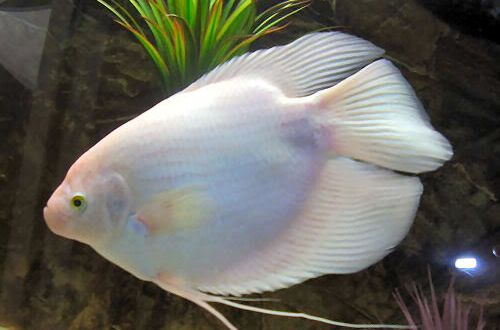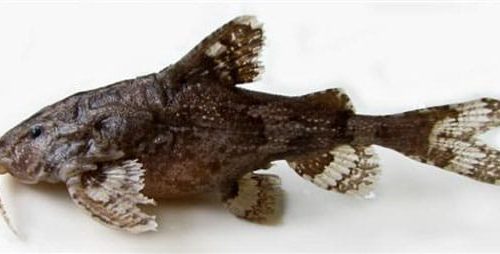
Redtail Gourami
The giant red-tailed gourami, scientific name Osphronemus laticlavius, belongs to the Osphronemidae family. Representative of one of the four giant gourami species and perhaps the most colorful of them. It was presented at thematic exhibitions as an aquarium fish only in 2004. Currently, there are still difficulties with its acquisition, especially in Eastern Europe.

This is due to the fact that there is a large demand for this fish in Asia, which helps suppliers keep prices high and therefore prevents successful exports to other regions. However, the situation is gradually improving as the number of commercial breeders increases.
Habitat
A scientific description was given to this species relatively recently in 1992. Found in Southeast Asia in Malaysia and Indonesia. It lives in rivers and lakes, during the rainy season, as the forests are flooded, it moves to the forest canopy in search of food. Prefers strongly overgrown sites of reservoirs with stagnant or slightly flowing water. They feed on everything they can swallow: aquatic weeds, small fish, frogs, earthworms, insects, etc.
Description
A large massive fish, in aquariums it can reach 50 cm, the shape of the body is similar to the rest of the Gourami, with the exception of the head, it has a large hump / bump, like an enlarged forehead, sometimes referred to as the “occipital hump”. The predominant color is blue-green, the fins have a red edging, thanks to which the fish got its name. Sometimes there are deviations in the color scheme, with age the fish becomes red or partially red. In China, it is considered a great success to get such a fish, so the demand for it does not dry out.
Food
Completely omnivorous species, due to its size it is very voracious. Accepts any food intended for the aquarium (flakes, granules, tablets, etc.), as well as meat products: worms, bloodworms, insect larvae, pieces of mussels or shrimp. However, you should not feed the meat of mammals, Gourami cannot digest them. Also, he will not refuse boiled potatoes, vegetables, bread. It is recommended to feed once a day.
If you buy an adult, be sure to specify its diet, if the fish has been fed meat or small fish since childhood, then changing the diet will no longer work, which will result in serious financial costs.
Maintenance and care
The content is quite simple, provided that you have a place where you can place a tank with a volume of 600 liters or more. A filled aquarium with soil and equipment will weigh over 700 kg, not any floor can withstand such a weight.
Fish produce a large amount of waste, in order to reduce the load on the biosystem, several productive filters should be installed and water should be renewed by 25% once a week, if the fish lives alone, then the interval can be increased to 2 weeks. Other necessary equipment: heater, lighting system and aerator.
The main condition in the design is the presence of large spaces for swimming. Several shelters with groups of dense thickets of plants will create favorable comfortable conditions. Plants should be purchased fast-growing, Gurami will regale on them. Dark ground will encourage brighter coloration.
Social behavior
It is considered a peaceful species, but there are exceptions, some large males are aggressive and seek to protect their territory by attacking other fish. Also because of their size and natural diet, small fish will become their food. Joint keeping is allowed with other large fish and it is desirable that they grow up together to avoid conflicts in the future. The species aquarium with one fish or a pair of male / female looks most preferable, but it is problematic to determine them, there are practically no differences between the sexes.
Breeding / breeding
Breeding at home is not advisable. There are no differences between the sexes, therefore, in order to guess with a couple, you should purchase several fish at once, for example, five pieces. Such an amount requires a very large aquarium (more than 1000 liters), in addition, as they grow older, conflicts may arise between males, which will certainly be 2 or more. Based on this, it is very problematic to breed the Giant Red-tailed Gourami.
Diseases
There are no health problems in a balanced aquarium with a stable biosystem. Read more about symptoms and treatments in the Aquarium Fish Diseases section.





